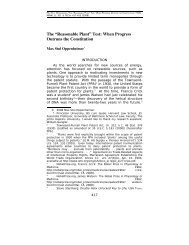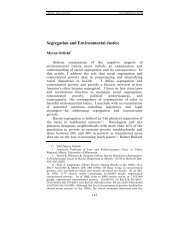An Organizational Approach to the Design of Patent Law
An Organizational Approach to the Design of Patent Law
An Organizational Approach to the Design of Patent Law
Create successful ePaper yourself
Turn your PDF publications into a flip-book with our unique Google optimized e-Paper software.
6 VERTINSKY FINAL_JAD (DO NOT DELETE) 2/27/2012 2:20 PM<br />
2012] AN ORGANIZATIONAL APPROACH 241<br />
B. FRAMEWORK FOR CHARACTERIZING THE INSTITUTIONAL<br />
ENVIRONMENT<br />
According <strong>to</strong> <strong>the</strong> organizational approach, patents are one<br />
<strong>of</strong> many institutions that, <strong>to</strong>ge<strong>the</strong>r with governance structures,<br />
characterize <strong>the</strong> institutional environment within which transactions<br />
take place. 134 The institutional environment consists <strong>of</strong><br />
five interconnected levels <strong>of</strong> social analysis which constrain behavior.<br />
These levels are: (1) “cognition,” or individual patterns<br />
<strong>of</strong> decision making under uncertainty, (2) “informal rules,” or<br />
“embedded institutions,” including <strong>the</strong> formation and effect <strong>of</strong><br />
norms, values and conventions that shape <strong>the</strong> context <strong>of</strong> innovation,<br />
such as those governing <strong>the</strong> “production” <strong>of</strong> science and<br />
technological advance, and those influencing and constraining<br />
<strong>the</strong> evolution and effects <strong>of</strong> patent laws; (3) “formal rules,” or<br />
<strong>the</strong> “institutional environment,” <strong>the</strong> direct constraints on decision<br />
making, including patent rights and o<strong>the</strong>r formal rules<br />
relevant <strong>to</strong> processes <strong>of</strong> innovation; (4) “governance structures,”<br />
or “institutional arrangements,” such as firms, different market<br />
structures, government, and hybrid forms <strong>of</strong> collaboration; and<br />
(5) “institutions <strong>of</strong> resource allocation,” such as marginal<br />
changes in activity levels in response <strong>to</strong> stronger or weaker patent<br />
rights. 135 Opportunities for policy intervention occur at different<br />
levels <strong>of</strong> <strong>the</strong> framework. Interaction occurs between <strong>the</strong><br />
different levels. 136 In some cases <strong>the</strong> interactions may streng<strong>the</strong>n<br />
<strong>the</strong> effectiveness <strong>of</strong> a policy change, but in o<strong>the</strong>r cases <strong>the</strong>y<br />
may inhibit it. The framework provides a way <strong>of</strong> structuring<br />
<strong>the</strong> analysis that a policy maker would engage in when choosing<br />
between alternative patent laws, such as presumptive versus<br />
limited availability <strong>of</strong> injunctions against patent infringers,<br />
based on likelihood <strong>of</strong> achieving desired innovation objectives.<br />
134. Williamson provides an analytical framework for examining changes<br />
in economic behavior that emphasizes <strong>the</strong> interaction between four levels <strong>of</strong><br />
social analysis and <strong>the</strong> differential rates <strong>of</strong> change at different levels, and I<br />
adapt this framework <strong>to</strong> <strong>the</strong> needs <strong>of</strong> patent law. Williamson, The New Institutional<br />
Economics: Taking S<strong>to</strong>ck, Looking Ahead, supra note 75, at 595–600;<br />
Williamson, Human Ac<strong>to</strong>rs and Economic Organization, supra note 82, at 1–4,<br />
34–35.<br />
135. See Williamson, supra note 75, at 595–600.<br />
136. These five layers <strong>of</strong> analysis are adapted from Williamson’s four levels<br />
<strong>of</strong> social analysis <strong>to</strong> fit <strong>the</strong> needs <strong>of</strong> patent law. Williamson’s four levels <strong>of</strong><br />
analysis are embeddedness, <strong>the</strong> institutional environment, governance, and<br />
resource allocation. See id.






